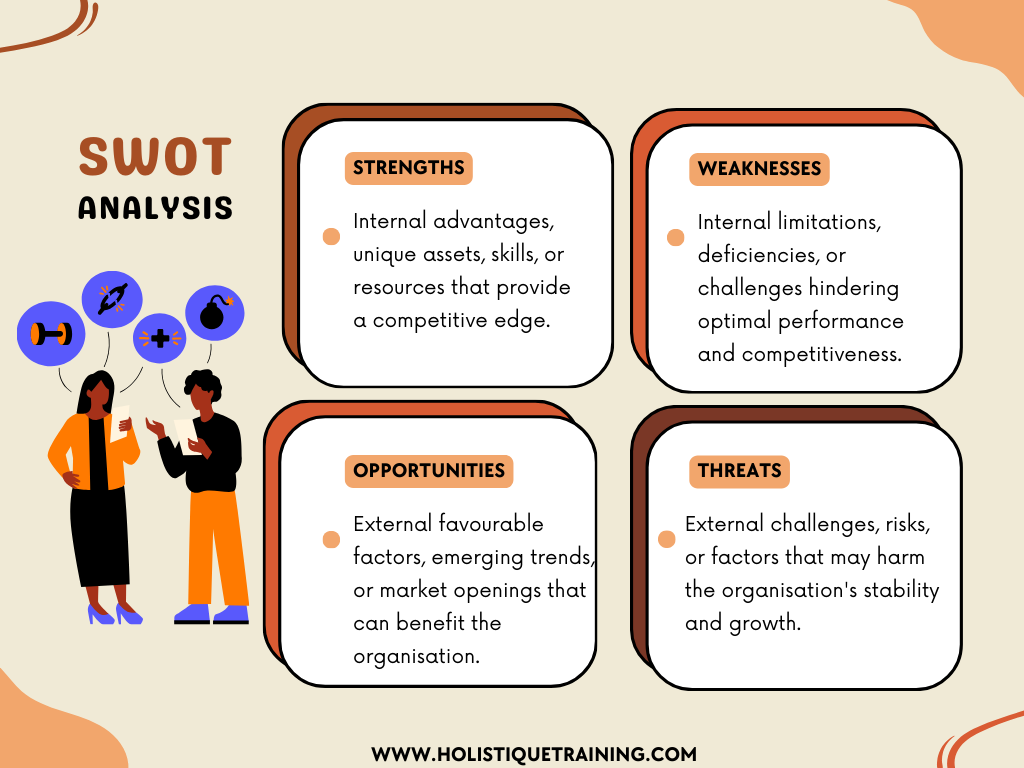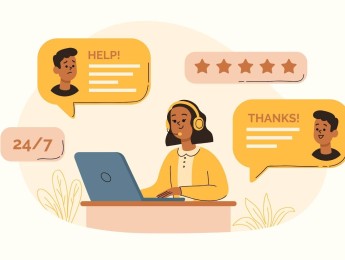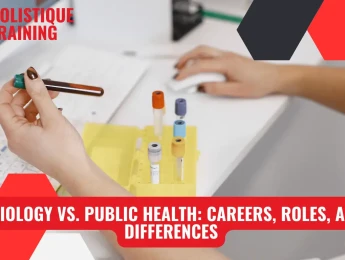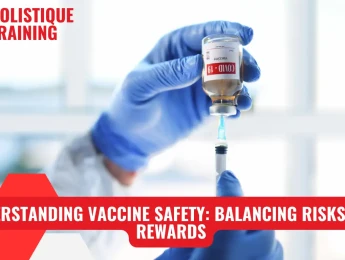- Table of Contents
- Introduction
- What Is a SWOT Analysis?
- Cases in Which a SWOT Analysis Is Used
- 1. Launching New Products or Services
- 2. Entering New Markets
- 3. Periods of Significant Change
- 4. Evaluating Competitors
- 5. Exploring Potential Partnerships
- 6. Assessing Organisational Health
- Components of SWOT Analysis
- 1. Strengths
- 2. Weaknesses
- 3. Opportunities
- 4. Threats
- Benefits of SWOT Analysis
- Comprehensive Understanding
- Informed Strategic Planning
- Resource Optimisation
- Risk Mitigation
- Enhanced Adaptability
- Improved Communication and Collaboration
- SWOT Analysis Cons
- Subjectivity and Bias
- Simplistic View
- Lack of Prioritisation
- Static Nature
- Limited in Identifying Future Trends
- Overemphasis on Internal Factors
- How to Conduct a SWOT Analysis
- 1. Gather Information
- 2. Assemble a Diverse Team
- 3. Brainstorm
- 4. Categorise the Factors
- 5. Evaluate and Prioritise
- 6. Develop Strategies
- 7. Review and Refine
- 8. Create an Action Plan
- 9. Regularly Update the Analysis
- Tips and Tricks When Writing a SWOT Analysis
- 1. Be Specific and Provide Examples
- 2. Use a Collaborative Approach
- 3. Focus on Relevance
- 4. Visualise the Analysis
- 5. Be Honest and Objective
- 6. Consider the Competitive Landscape
- 7. Link SWOT Factors to Strategies
- Got My SWOT Analysis Results. Now What?
- Develop Action Plans
- Set Clear Objectives
- Allocate Resources Wisely
- Monitor Progress and Adapt
- Communicate Internally and Externally
- Integrate SWOT into Decision-Making Processes
- Encourage a Culture of Continuous Improvement
- Conclusion
Introduction
Every strategic decision in the business world involves a multitude of factors. Analysing these factors effectively is essential for making informed choices to steer a business toward success. SWOT analysis is a powerful tool that helps organisations comprehensively understand their internal and external environments. SWOT stands for Strengths, Weaknesses, Opportunities, and Threats. In this article, we will delve deep into the intricacies of SWOT analysis, exploring its various aspects, applications, and the impact of technology on this strategic planning tool.
What Is a SWOT Analysis?
At its core, a SWOT analysis is a strategic planning technique used to identify an organisation's Strengths, Weaknesses, Opportunities, and Threats. It offers a structured way to evaluate these internal and external factors, enabling businesses to make well-informed decisions and craft effective strategies. By understanding these elements, organisations can leverage their strengths, address weaknesses, capitalise on opportunities, and mitigate potential threats.
Cases in Which a SWOT Analysis Is Used
SWOT analysis is a versatile tool that finds applications in many business scenarios. Its ability to distil complex information into comprehensible categories makes it indispensable for organisations striving to thrive in the ever-evolving business landscape.
1. Launching New Products or Services
Before a product or service hits the market, businesses conduct a SWOT analysis to gauge its viability. By assessing the product's strengths (unique features, superior quality), weaknesses (potential flaws, high production costs), opportunities (gaps in the market, changing consumer preferences), and threats (competitor reactions, regulatory challenges), companies can refine their offerings and develop effective marketing strategies.
2. Entering New Markets
Expanding into new markets presents a multitude of challenges and opportunities. By conducting a SWOT analysis specific to the target market, businesses can identify the unique demands of local consumers (opportunities), potential cultural or legal hurdles (threats), their brand reputation and product appeal (strengths), and areas needing adaptation (weaknesses). This insight guides market entry strategies, ensuring a smooth transition and reducing risks.
3. Periods of Significant Change
SWOT analysis provides clarity amidst uncertainty during mergers, acquisitions, restructuring, or leadership changes. It helps organisations assess the strengths and weaknesses of merging entities, identify synergies and potential conflicts (opportunities and threats), and devise integration strategies that leverage the best of both worlds. Similarly, during leadership transitions, analysing internal strengths and weaknesses aids in continuity planning and maintaining organisational stability.
4. Evaluating Competitors
Understanding one's competitors is crucial for strategic positioning. By conducting a competitive SWOT analysis, businesses can identify rival companies' strengths (market dominance, innovative products), weaknesses (poor customer service, limited distribution channels), opportunities (gaps in their strategies, market expansion potential), and threats (emerging competitors, disruptive technologies). This intelligence informs competitive strategies, helping businesses exploit their competitors' weaknesses while shoring up their own defences.
5. Exploring Potential Partnerships
A SWOT analysis can uncover mutual benefits and risks when considering partnerships, whether with suppliers, distributors, or collaborators. By evaluating each party's strengths and resources (complementary skills, financial stability), weaknesses (limited resources, operational challenges), opportunities (shared customer base, joint marketing initiatives), and threats (market fluctuations, legal complications), businesses can enter partnerships with a clear understanding of what each party brings to the table and anticipate potential challenges.
6. Assessing Organisational Health
Regularly conducting SWOT analyses internally helps organisations assess their overall health. By evaluating internal processes, employee skills, financial stability, and market reputation, companies can identify areas for improvement, optimise their operations, and align their strategies with their objectives. This introspection ensures that businesses remain agile and responsive in the face of changing market dynamics.
In summary, SWOT analysis is a fundamental tool that empowers businesses to make strategic decisions in various contexts. SWOT analysis equips organisations with valuable insights by providing a structured framework for evaluating internal strengths and weaknesses alongside external opportunities and threats. It enables them to navigate challenges, capitalise on opportunities, and ultimately achieve sustainable growth and success.
Components of SWOT Analysis
A SWOT analysis is akin to dissecting an organisation's DNA, revealing its intrinsic traits and external interactions. Each component—strengths, Weaknesses, Opportunities, and Threats—contributes uniquely to the overall understanding of the business environment. Let's delve deeper into these components to unravel the essence of SWOT analysis.
1. Strengths
Strengths are the lifeblood of an organisation. They are the internal assets, capabilities, and positive attributes that set a company apart from its competitors. Strengths can encompass many factors, such as a strong brand reputation, a skilled and motivated workforce, efficient operational processes, innovative product offerings, or robust financial resources. These strengths form the foundation for a business to build its competitive advantage, providing a solid platform for growth and success. Identifying and leveraging strengths is crucial for maximising opportunities and mitigating threats effectively.
2. Weaknesses
Weaknesses represent the internal vulnerabilities and limitations within an organisation. These can be areas where the company lags behind its competitors, or internal challenges that hinder optimal performance. Weaknesses might include outdated technology, insufficient resources, lack of skilled personnel, inefficient processes, or poor customer service. Identifying weaknesses is vital for organisations as it helps them pinpoint areas that require improvement and strategic intervention. Addressing weaknesses is essential for enhancing operational efficiency, customer satisfaction, and overall competitiveness in the market.
3. Opportunities
Opportunities are external factors that can benefit the organisation if capitalised upon effectively. These external factors can include emerging market trends, technological advancements, changes in consumer preferences, untapped market segments, strategic partnerships, or favourable economic conditions. Recognising opportunities allows businesses to align their strategies to exploit these favourable circumstances. By seizing opportunities, organisations can expand their market presence, increase revenue streams, and gain a competitive edge in the industry.

4. Threats
Threats are external factors that pose potential challenges and risks to an organisation's stability and growth. These threats can take various forms, such as intense competition, economic downturns, regulatory changes, technological disruptions, or shifting consumer behaviours. Identifying threats is crucial for businesses to prepare and strategise how to mitigate their impact proactively. Understanding potential threats enables organisations to develop contingency plans, enhance resilience, and stay prepared to navigate adversities effectively.
In the intricate web of business dynamics, the interaction of these four components creates a holistic picture of an organisation's current standing and future potential. Strengths and weaknesses are internal, intrinsic factors that reflect the organisation's core competencies and limitations. On the other hand, opportunities and threats are external, dynamic factors shaped by the ever-changing market forces and industry landscapes.
By meticulously analysing these components, businesses can craft informed strategies that capitalise on their strengths and opportunities while addressing their weaknesses and mitigating threats. SWOT analysis guides organisations toward sound decision-making, strategic planning, and sustainable growth in an increasingly competitive business world. It is not just a tool; it is the cornerstone upon which resilient and adaptive businesses are built, ensuring they navigate the complexities of the market with confidence and foresight.
Benefits of SWOT Analysis
In the fast-paced and competitive landscape of the business world, strategic decision-making is paramount. Regardless of their size or industry, organisations need a reliable tool to assess their current position, identify opportunities, and mitigate potential risks. This is where SWOT analysis steps in, offering many benefits that empower businesses in their strategic endeavours.
Comprehensive Understanding
One of the primary benefits of SWOT analysis is its ability to comprehensively understand the internal and external factors affecting an organisation. By systematically evaluating strengths, weaknesses, opportunities, and threats, businesses gain valuable insights into their current state and the surrounding business environment. This deep understanding serves as the foundation for informed decision-making.
Informed Strategic Planning
SWOT analysis acts as a roadmap for strategic planning. Organisations can devise strategies that capitalise on their unique advantages and market conditions by highlighting internal strengths and external opportunities. Simultaneously, identifying weaknesses and threats allows businesses to develop proactive measures, ensuring that potential challenges are addressed before they escalate. Informed strategic planning enables businesses to align their resources, efforts, and investments in directions that maximise positive outcomes.
Resource Optimisation
Understanding internal strengths through SWOT analysis helps organisations optimise their resources effectively. By focusing on their core competencies and unique selling propositions, businesses can channel their human, financial, and technological resources toward activities that enhance their competitive advantage. This strategic resource allocation ensures that investments yield higher returns and contribute significantly to the organisation's overall objectives.
Risk Mitigation
SWOT analysis equips businesses with the foresight to identify potential threats in advance. Organisations can develop risk mitigation strategies by recognising market challenges, technological disruptions, or regulatory changes. These strategies may include diversifying product offerings, enhancing operational flexibility, or establishing contingency plans. Proactive risk mitigation minimises the impact of unforeseen events, safeguarding the organisation's stability and continuity.
Enhanced Adaptability
In today's dynamic business environment, adaptability is key to survival. SWOT analysis enables organisations to stay agile by regularly assessing their strengths, weaknesses, opportunities, and threats. This continuous evaluation ensures that businesses can adapt swiftly to changing market conditions, consumer preferences, and competitive landscapes. An adaptable organisation can pivot its strategies and offerings, remaining relevant and responsive to evolving market demands.
Improved Communication and Collaboration
SWOT analysis often involves collaboration among diverse teams and stakeholders within an organisation. Engaging in the analysis process fosters open communication, knowledge sharing, and a collective understanding of the business's dynamics. This collaborative effort enhances the quality of the analysis and strengthens employee teamwork and cohesion. Improved communication and collaboration facilitate the development and execution of cohesive strategies that align with the organisation's overarching goals.
In summary, SWOT analysis has multifaceted benefits. It provides organisations with a strategic lens through which they can assess their internal capabilities, external opportunities, and potential challenges. By leveraging these insights, businesses can make well-informed decisions, allocate resources judiciously, and proactively navigate the complexities of the business landscape. SWOT analysis is not merely a tool; it is a catalyst for organisational growth, resilience, and sustained success, enabling businesses to thrive in the face of uncertainty and competition.
SWOT Component | Example (for a Coffee Shop) | Impact |
Strengths | Skilled Baristas | High Customer Satisfaction |
Weaknesses | Limited Seating Space | Lower Customer Turnover |
Opportunities | New Location in Busy Business District | Increased Foot Traffic |
Threats | Competing Cafes Nearby | Potential Revenue Loss |
Table 1: SWOT analysis example
SWOT Analysis Cons
While SWOT analysis is a valuable tool for strategic planning, it has limitations. Organisations must understand these drawbacks to use SWOT analysis effectively and mitigate potential pitfalls. Here are some of the key cons associated with SWOT analysis:
Subjectivity and Bias
One of the primary limitations of SWOT analysis is its susceptibility to subjectivity and bias. Different stakeholders within an organisation may perceive the same factor differently, leading to inconsistencies in the analysis. Personal opinions, experiences, and perspectives can influence how strengths, weaknesses, opportunities, and threats are identified and evaluated. This subjectivity can distort the accuracy of the analysis, potentially leading to flawed strategic decisions.
Simplistic View
SWOT analysis provides a simplified and static view of complex business environments. It categorises factors into four discrete groups, which may not capture the nuanced interconnections between these elements. Real-world situations are often intricate and multifaceted, involving overlapping factors that cannot be neatly compartmentalised. Relying solely on SWOT analysis might overlook the intricacies of the business landscape, limiting the depth of strategic insights.
Lack of Prioritisation
While SWOT analysis helps identify various factors, it does not inherently prioritise them. Not all identified strengths, weaknesses, opportunities, and threats carry the same weight in influencing strategic decisions. Failing to prioritise these factors can result in a scattered approach to strategy development, where less significant ones might overshadow essential issues. Organisations need additional methodologies to prioritise factors effectively and focus their efforts on the most critical aspects.
Static Nature
SWOT analysis offers a snapshot of the organisation's situation at a specific point in time. However, business environments are dynamic and constantly evolving due to market trends, technological advancements, economic fluctuations, and other factors. Factors identified in a SWOT analysis might change rapidly, rendering the analysis outdated. Organisations must regularly update their SWOT analysis to reflect the changing landscape to maintain relevance, ensuring that strategic decisions are based on current and accurate information.
Limited in Identifying Future Trends
While SWOT analysis is effective at assessing the present, it is less adept at predicting future trends. Identifying emerging opportunities or threats that have not yet materialised can be challenging through traditional SWOT analysis. Businesses must complement SWOT analysis with other forecasting tools and trend analysis methodologies to anticipate future market shifts and stay ahead of the curve.
Overemphasis on Internal Factors
SWOT analysis focuses more on internal factors (strengths and weaknesses) than external factors (opportunities and threats). While internal factors are crucial, overemphasising them can lead to a myopic view of the business environment. Ignoring external opportunities and threats can hinder a business's ability to capitalise on emerging trends or proactively address potential challenges.
In short, while SWOT analysis is a valuable tool, organisations must recognise its limitations. Awareness of these cons allows businesses to use SWOT analysis as part of a more comprehensive strategic planning process. By combining SWOT analysis with other strategic frameworks, trend analysis, and expert insights, organisations can navigate the complexities of the business landscape more effectively, ensuring that their strategies are well-informed, adaptive, and forward-looking.
How to Conduct a SWOT Analysis
A SWOT analysis requires a structured and methodical approach to ensure accurate assessments and meaningful insights. Here's a step-by-step guide on how to conduct a SWOT analysis effectively:
1. Gather Information
Collect relevant data about your organisation, industry trends, market conditions, customer feedback, and competitors. This information forms the foundation of your analysis and provides a factual basis for your assessments. Ensure the data you gather is current and reliable to make your analysis as accurate as possible.
2. Assemble a Diverse Team
Involve a diverse group of stakeholders in the analysis process. This could include executives, managers, employees from different departments, and even external consultants or industry experts. Different perspectives bring broader insights, leading to a more comprehensive SWOT analysis.
3. Brainstorm
Organise a brainstorming session where team members can freely discuss and identify internal strengths and weaknesses and external opportunities and threats. Encourage open and honest communication, allowing participants to express their viewpoints without judgment. Use techniques like mind mapping or affinity diagrams to visualise ideas and connections.
4. Categorise the Factors
Once you have a list of identified factors, categorise them into the four SWOT components mentioned above. Here’s a brief summary of each:
- Strengths: List internal attributes and resources that give your organisation a competitive advantage.
- Weaknesses: Identify internal limitations and challenges that hinder your organisation's performance.
- Opportunities: Explore external factors that can benefit your organisation if leveraged effectively.
- Threats: Recognise external factors that could negatively impact your organisation's operations and objectives.
5. Evaluate and Prioritise
Evaluate each factor's significance and prioritise them based on their impact and importance. Consider factors such as the potential impact on revenue, customer satisfaction, operational efficiency, or long-term sustainability. Prioritisation helps focus attention on the most critical issues that require strategic intervention.
6. Develop Strategies
Use the SWOT analysis to develop specific strategies that leverage strengths, address weaknesses, capitalise on opportunities, and mitigate threats. Strategies should be actionable, measurable, and aligned with your organisation's overall goals. Each strategy should target a specific factor identified in the SWOT analysis and outline the steps needed for implementation.
7. Review and Refine
After developing strategies, review them with the team to gather feedback and refine the action plans. Ensure the strategies are realistic, achievable, and compatible with your organisation's resources and capabilities. Make any necessary adjustments to enhance the effectiveness of the proposed strategies.
8. Create an Action Plan
Translate the refined strategies into a detailed action plan with specific tasks, deadlines, responsible parties, and performance metrics. A well-defined action plan provides clear guidance on the steps to be taken, ensuring the strategies are executed effectively. Regularly monitor progress and make adjustments as needed to stay on track.
9. Regularly Update the Analysis
Recognise that your business environment is dynamic, with factors constantly changing. Regularly update your SWOT analysis to reflect these changes and ensure its relevance. An updated analysis provides valuable insights for ongoing strategic decision-making, allowing your organisation to adapt to emerging market conditions and opportunities.
Following this systematic approach, businesses can conduct a thorough, well-informed, and actionable SWOT analysis. A well-executed SWOT analysis is a powerful tool for strategic planning, enabling organisations to make informed decisions, capitalise on their strengths, and proactively address challenges, ultimately leading to sustainable growth and success.
Tips and Tricks When Writing a SWOT Analysis
Writing a SWOT analysis involves more than just listing strengths, weaknesses, opportunities, and threats. To create a compelling and impactful SWOT analysis, consider the following tips and tricks:
1. Be Specific and Provide Examples
When identifying strengths, weaknesses, opportunities, and threats, be specific. Instead of general statements, provide concrete examples and evidence to support your points. Specific examples enhance clarity and credibility, allowing readers to understand each factor's context and significance better.
For example, instead of stating "Strong brand reputation," provide specific examples of successful marketing campaigns, customer testimonials, or industry awards that showcase your brand's reputation.
2. Use a Collaborative Approach
Involve a diverse group of stakeholders in the analysis process. Different perspectives bring a broader range of insights. Engaging key employees, managers, and even customers or clients can provide valuable viewpoints that might be overlooked otherwise. A collaborative approach ensures a well-rounded and comprehensive SWOT analysis.
3. Focus on Relevance
Concentrate on factors directly relevant to your business objectives and strategic goals. Avoid including unnecessary details or unrelated information. A focused analysis is more impactful and easier for readers to digest. Prioritise factors that significantly impact your organisation's performance and decision-making processes.
4. Visualise the Analysis
Consider using charts, graphs, or diagrams to present the SWOT analysis visually. Visual representations enhance the clarity of the information and make it easier for readers to grasp the key points at a glance. Visualising the analysis can provide a clear overview of the internal and external factors, making the information more accessible and engaging for your audience.
5. Be Honest and Objective
Maintain objectivity and honesty when evaluating your organisation's strengths and weaknesses. Acknowledge limitations and challenges, even if they are uncomfortable to address. A candid assessment provides a realistic foundation for strategic planning and decision-making. Avoid sugar-coating weaknesses or downplaying threats, which can lead to misguided strategies.
6. Consider the Competitive Landscape
When evaluating strengths and weaknesses, consider how your organisation compares to competitors in the industry. Understanding your competitive position provides valuable context. Highlight unique strengths that set you apart and be aware of weaknesses that might hinder your ability to compete effectively. Analysing the competitive landscape enhances the strategic relevance of your SWOT analysis.
7. Link SWOT Factors to Strategies
Connect each identified factor to specific strategies or action plans. Clearly articulate how you plan to leverage strengths, address weaknesses, capitalise on opportunities, and mitigate threats. Linking SWOT factors to strategies demonstrates a proactive approach and provides a roadmap for implementation. Concrete strategies transform the SWOT analysis from a theoretical exercise into a practical guide for decision-makers.
By incorporating these tips and tricks, your SWOT analysis can become a powerful tool for strategic planning, guiding your organisation toward well-informed decisions, effective strategies, and sustainable growth. Clarity, specificity, and relevance are key to creating a SWOT analysis that informs and inspires action and innovation within your organisation.
Got My SWOT Analysis Results. Now What?
Completing a SWOT analysis is a significant step, but its true value lies in leveraging the insights gained. The results of your SWOT analysis are a treasure trove of strategic information that, when used effectively, can shape your organisation's future. Here's how to transform your SWOT analysis results into actionable strategies and initiatives:
Develop Action Plans
Translate the identified strengths into strategies that amplify your competitive advantages. Address weaknesses through targeted initiatives to improve internal processes, enhance skills, or invest necessary resources. Exploit opportunities by developing innovative products or services and expanding into new markets. Mitigate threats by establishing contingency plans and diversifying your offerings. Each element of your SWOT analysis should be linked to specific action plans that guide your organisation toward its goals.
Set Clear Objectives
Based on your SWOT analysis, establish clear and measurable objectives that align with your strengths and opportunities while addressing your weaknesses and threats. Objectives should be specific, measurable, achievable, relevant, and time-bound (SMART). Setting precise objectives provides a roadmap for your organisation, ensuring everyone understands what needs to be accomplished and by when.
Allocate Resources Wisely
Use your SWOT analysis to prioritise resource allocation. Allocate your budget, time, and human capital to initiatives that align with your strengths and opportunities. Prioritise investments that address critical weaknesses and threats, ensuring that resources are directed toward areas where they can have the most significant impact. Effective resource allocation enhances efficiency and maximises the return on investment.
Monitor Progress and Adapt
Monitor the progress of your action plans and initiatives regularly. Establish key performance indicators (KPIs) that align with your objectives and use them to track your organisation's performance. Analyse the outcomes and adjust your strategies as needed. A proactive approach to monitoring and adaptation ensures that your organisation remains agile, responding effectively to changing circumstances and market dynamics.
Communicate Internally and Externally
Share the findings of your SWOT analysis and the corresponding strategies with your internal teams. Transparent communication fosters a shared understanding of the organisation's direction and goals. It also empowers employees to contribute meaningfully to the implementation of the strategies. Additionally, consider sharing relevant aspects of your SWOT analysis with external stakeholders, such as customers, suppliers, and partners. Transparent communication builds trust and can lead to collaborative opportunities.
Integrate SWOT into Decision-Making Processes
Incorporate the insights from your SWOT analysis into your regular decision-making processes. When faced with strategic decisions, refer back to your SWOT analysis to inform your choices. Evaluate potential opportunities and threats against your organisation's strengths and weaknesses. Integrating SWOT analysis into decision-making ensures that your strategies remain aligned with your overall objectives, enhancing the coherence and effectiveness of your actions.
Encourage a Culture of Continuous Improvement
Use the SWOT analysis as a catalyst for fostering a culture of continuous improvement within your organisation. Encourage feedback and suggestions from employees at all levels. Regularly revisit your SWOT analysis, updating it to reflect changes in the internal and external environment. By embracing a continuous improvement mindset, your organisation can stay ahead of the competition and adapt to evolving market demands.
In essence, the results of your SWOT analysis should not be confined to a document but should permeate every aspect of your organisation's operations. By transforming your SWOT analysis insights into actionable strategies, clear objectives, resource allocation plans, and a culture of continuous improvement, you can harness the full potential of your organisation and navigate the complexities of the business landscape with confidence and agility. Remember, a SWOT analysis is not a one-time task but a dynamic tool that, when utilised effectively, can drive your organisation toward sustained growth and success.
Conclusion
SWOT analysis remains a fundamental strategic planning tool for businesses worldwide. Its ability to offer a holistic view of internal and external factors empowers organisations to make informed decisions and adapt to changing market dynamics. By embracing technology and following best practices, businesses can maximise the potential of SWOT analysis, ensuring it remains a cornerstone of their strategic planning efforts.
Incorporate the power of SWOT analysis into your organisation's strategy with our ‘Comprehensive Quality Control and Assurance’ course. Elevate your skills, master the art of strategic planning, and gain a competitive edge in the dynamic business landscape. Join us today to unlock the secrets of strategic success!























